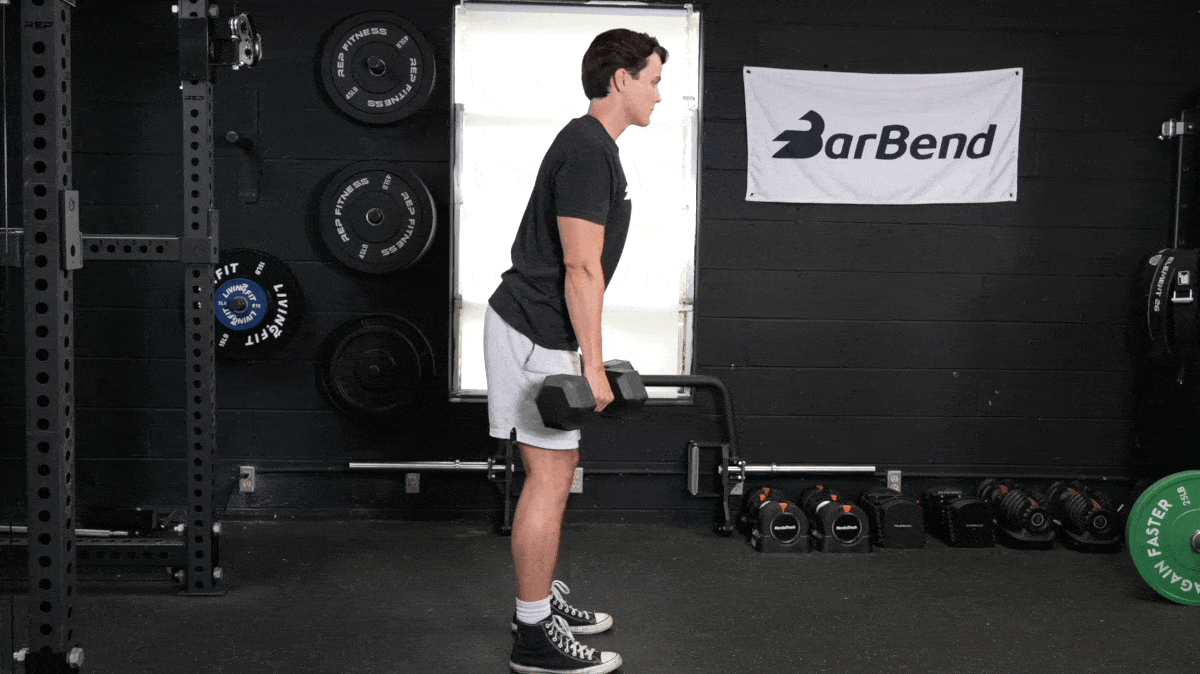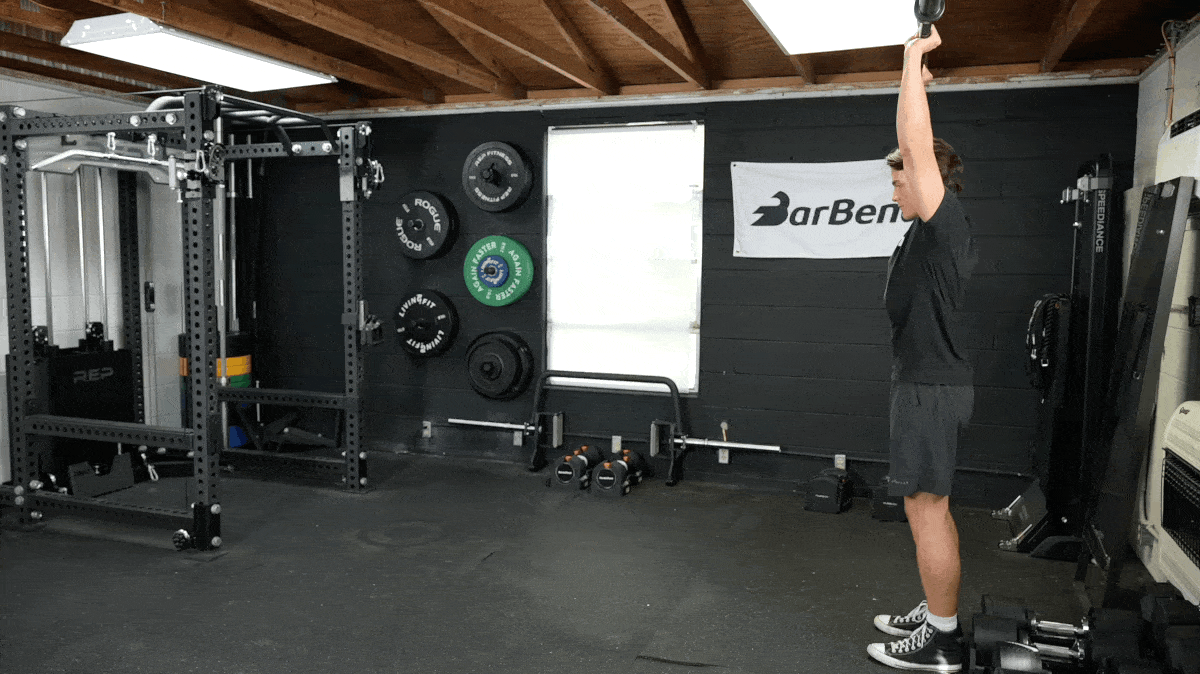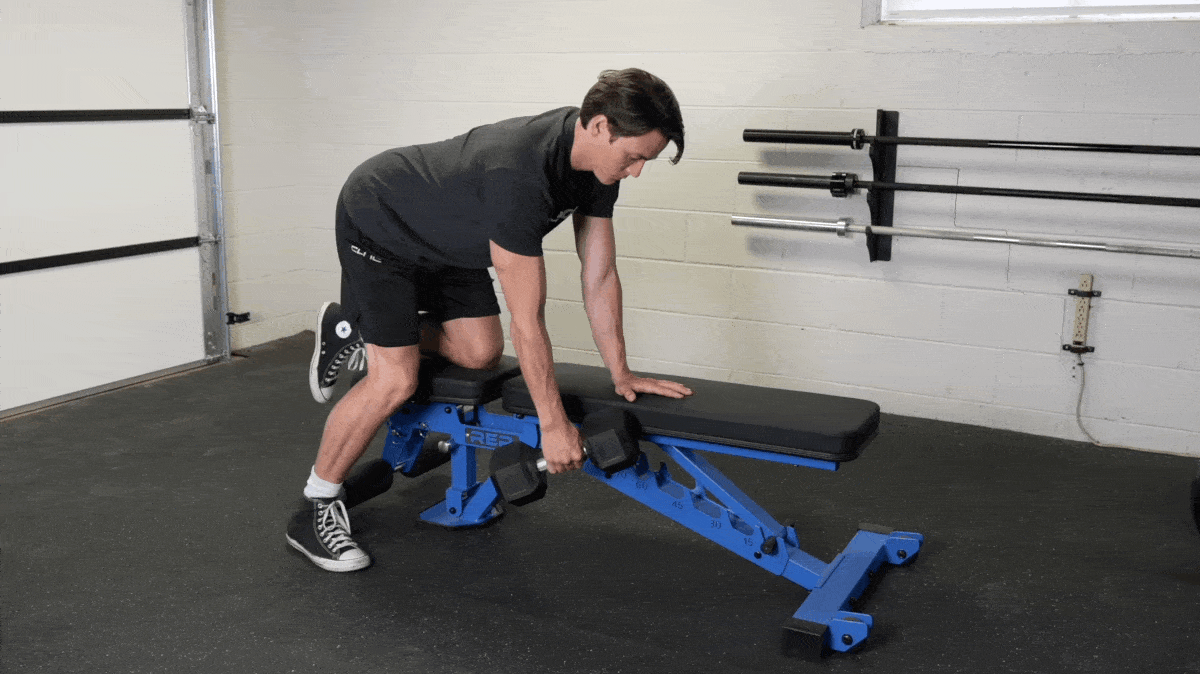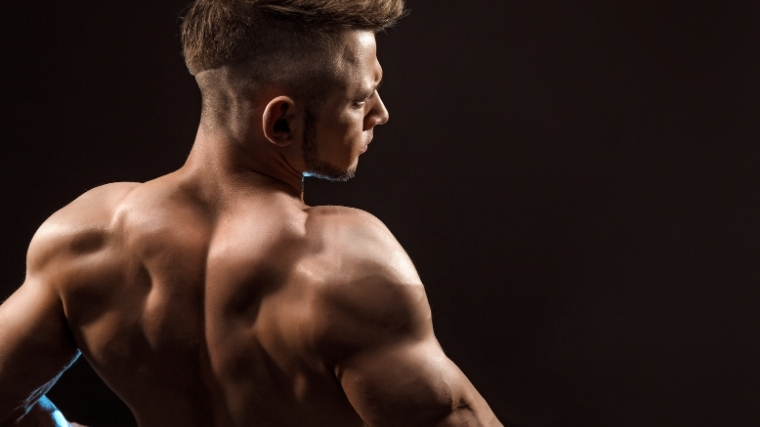Traps may be the new abs to strength athletes — at least in the sense that they’re hard to obtain and signal to the world that you take your fitness goals seriously. Just like you can’t get abs without following a strict and calculated diet, big traps require years of heavy lifting, smart recovery, and targeted programming.

Exercise selection also plays an important role. There are more ways to build a set of steel traps than just barbell shrugs, and we’re going to show you how. On the list below, we outline 13 of the best exercises for the traps, along with a deep dive into the benefits of trap training, and the best trap workouts you can perform.
Editor’s Note: The content on BarBend is meant to be informative in nature, but it shouldn’t take the place of advice and/or supervision from a medical professional. The opinions and articles on this site are not intended for use as diagnosis, prevention, and/or treatment of health problems. Speak with your physician if you have any concerns.
13 Best Trap Exercises
- Trap Bar Shrug
- Cable Shrug
- Dumbbell Shrug
- Kirk Shrug
- Overhead Barbell Carry
- Farmer’s Carry
- Dumbbell Row
- Trap Bar Deadlift
- Rack Pull
- Dumbbell Prone Y-Raise
- EZ-Bar Upright Row
- Rope Pull Apart
- Dumbbell Lateral Raise
1. Trap Bar Shrug
Trap bar shrugs are a great way to overload the traps because you can use heavy loads safely. The trap bar has you assume a grip that helps minimize the stress on the anterior shoulder, elbows, and wrists.
[Read More: The Best Shoulder Exercises for Building Muscle]
The trap bar shrug can also be programmed for strength, muscle hypertrophy, or power development, making it a versatile training tool.
How To Do It
- Perform a standard deadlift with the trap bar to begin the exercise from a standing position.
- Once motionless, shrug the shoulders up and towards the ears.
- Once at the top, lower under control.
Coach’s Tip: Focus on elevating your shoulders without rounding them forward.
Sets and Reps: Shrug for 3 sets of 12 reps.
2. Cable Shrug
The cable shrug is an excellent exercise to target the traps, rear delts, and upper back. The cable stack allows for precise loading, which is beneficial for higher rep sets and methods such as drop sets, tempo, and pauses.
[Read More: The Best Back Workouts]
Unlike some of the other exercises on this list, the cable’s constant tension ensures that you fully fatigue the traps throughout their entire range of motion.
How To Do It
- Stand in front of a cable machine and grab the rope attachment with both hands and feet shoulder-width apart.
- Keep your shoulders down, chest up, and hold the rope with arms extended.
- Without using your arms, exhale and bring your shoulders towards your ears and then pull back slightly.
- Pause and slowly return to the starting position.
Coach’s Tip: Cables provide constant mechanical tension to your traps. Take your reps slowly and feel that tension from start to finish.
Sets and Reps: Perform 2 sets of 12 to 15 reps.
3. Dumbbell Shrug
The dumbbell shrug allows for unilateral strength training and helps to iron out potential imbalances. While it is more difficult to load up serious weight with the dumbbell shrug, you can use methods to increase tension such as performing drop sets, lifting with tempo, or adding pauses.

Plus, unlike the trap bar or barbell, dumbbells are particularly effective at improving grip strength.
How To Do It
- Grab a pair of dumbbells and stand tall with your shoulders depressed and chest up.
- Raise your upper traps towards your ears as high as you can.
- Pause for a second and slowly lower your shoulders down to the hang position. Reset and repeat for reps.
Coach’s Tip: Avoid bending your elbows as you shrug.
Sets and Reps: Try 2 or 3 sets of 12 to 15 reps here.
4. Kirk Shrug
Kirk Karwoski started doing this shrug variation to increase grip strength for the deadlift. His coach, Marty Gallagher, thought this exercise would help him pull heavier — and Marty was right.
Kirk pulled an 800-pound deadlift with the help of the Kirk Shrug. But they also discovered they built a bigger yoke too. By using a thumbless grip and a pause, this lift puts incredible tension on your upper traps.
How To Do It
- Assume a thumbless grip on the barbell and perform a standard shrug from a standing position.
- As you shrug, bend the elbows as you shrug as if you were doing the first half of an upright row.
- Hold the barbell at the top of the movement if possible before lowering the weight to the starting position.
Coach’s Tip: The barbell should come up to about belly button height.
Sets and Reps: Perform 3 sets of 15 reps here.
5. Barbell Overhead Carry
There are many variations of the overhead carry, but the standard-grip version allows for the heaviest load — and thus the highest stimulation.

This exercise seriously challenges your upper traps, shoulders, core, and triceps isometrically, while also being a great accessory move to improve your overhead presses and Olympic lifts.
How To Do It
- Set a bar at chest height in a power rack and unrack it.
- Perform a press, push press, or jerk to secure the barbell overhead.
- While keeping the barbell fixed above your head with locked arms, take small and controlled steps for distance or time.
Coach’s Tip: Fix your gaze on a point in front of you as you walk.
Sets and Reps: Try 2 or 3 rounds of 20 paces.
6. Farmer’s Carry
The farmer’s carry is a loaded carry workout variation that can benefit muscles across the upper body and lower body all at once. The traps play a vital role in stabilizing the scapula as it is the main muscle producing tension and stability in the upper back during any form of carry.

The farmer’s carry also helps with core strength and postural control, making it highly transferable to everyday life.
How To Do It
- With a dumbbell in each hand — consider using lifting straps if you aren’t concerned with grip strength — take steady, controlled steps in a straight line.
- Walk with an upright posture and don’t allow your body to list to one side or meander off your intended line.
Coach’s Tip: Let the shoulders hang away from the ears.
Sets and Reps: Try 2 rounds of 20 paces.
7. Dumbbell Row
Alongside the muscles of the arm, the one-arm dumbbell row challenges the traps in their role of scapular retraction (bringing the shoulder blades closer together).

This exercise packs a host of benefits, including the added need for stability compared to its barbell counterpart alongside its ability to focus on one side of the body at a time, enabling you to shore up weaknesses.
How To Do It
- Place the knee opposite the arm you’re rowing with onto a weight bench, plyo box, or another stable surface.
- Place the non-working arm down to support your torso.
- Pick up the dumbbell with a neutral grip (palms facing toward the body) and row it up, leading with your elbow.
- Pull the weight in a controlled manner without leaning your body to either side. Repeat on the opposite side.
Coach’s Tip: Make sure your back is straight and allow the free leg to extend behind you or to the side.
Sets and Reps: Bang out 3 or 4 sets of 8 to 12 reps.
8. Trap Bar Deadlift
The trap bar deadlift variation is one of the most underrated exercises around. It allows you to hold the load more in line with your body and with a neutral grip — which helps keep the torso more upright and allows for more weight to be loaded on the bar.
[Read More: Romanian Deadlift Vs. Deadlift — Which is Better for Your Program?]
Although you are not actively shortening and lengthening your traps, they are still receiving a massive isometric stimulus as they stabilize the shoulder girdle while your lower body works.
How To Do It
- While standing in the middle of the bar, squat down and grasp the handles.
- Brace your torso from top to bottom, and then lift the weight by driving your feet through the floor.
- Push until you come to a standing position with your knees locked out and your arms hanging down by your side.
Coach’s Tip: The action of the trap bar deadlift should feel more like a partial squat than a regular hinge.
Sets and Reps: Do 3 or 4 sets of 6 to 10 reps.
9. Rack Pull
The rack pull is a staple among strength and physique athletes alike. Sometimes controversial, this variation targets your upper and mid-back, alongside the lower body, and allows you to load up the bar with a truly insane amount of weight.

As with other deadlift variations, the intent of this exercise is to isometrically challenge the traps — an area in which the rack pull is king.
How To Do It
- While standing in a power rack, set the safety bars to around knee height.
- With your core tight and spine neutral, hinge at the hip, grab the bar, and then pull the barbell to lockout.
- Slowly lower the weight to the starting position, resisting the pull of the weight on the way down.
Coach’s Tip: The rack pull should be performed with weights that are heavier than what you’d normally deadlift.
Sets and Reps: Go heavy and perform 3 to 5 sets of 5 to 8 reps.
10. Dumbbell Prone Y-Raise
The lower aspect of the trapezius has a key role in stabilizing the scapula. Its main function is to depress the shoulder blades and aid in upward rotation. The prone y-raise allows you to load the lower traps, contributing to gains in strength, size, and function.

Exercises that target the lower traps are of particular value if you feel you have poor posture, as this portion of the muscle tends to go under-stimulated by traditional shrugging exercises. Balancing out your trap work is key for both posture and performance.
How To Do It
- Set an adjustable bench to roughly a 45 degree angle — the steeper the inclination, the more difficult each repetition will be.
- Slowly raise a pair of dumbbells out in front of your body such that, if viewed from overhead, your body would make a “Y” shape.
Coach’s Tip: The Y raise requires very light weights to be effective — newer trainees may not need any weight at all if they’re just getting started at the gym.
Sets and Reps: Take it slow and do 2 to 3 sets of up to 20 reps.
11. EZ-Bar Upright Row
This free-weight row variation trains the upper traps and muscles of the shoulder in their function of scapular elevation, upward rotation, and shoulder abduction. The upright row can be used by bodybuilders to build more size to the upper back and neck, and strength athletes can use this exercise to build shoulder strength and reinforce their technique in Olympic movements.
The EZ-bar, or cambered bar, will likely reduce stress on the wrists and elbows, making the move more comfortable.
How To Do It
- Place your hands on the bar slightly outside shoulder-width.
- With the body locked in place, raise the bar upwards as you elevate the shoulders, briefly pausing at the top of the row to flex the upper traps.
- Lower the weight under control.
Coach’s Tip: Unwrap your thumbs from the bar if you have any wrist discomfort during the movement.
Sets and Reps: Do 1 or 2 sets of 12 to 15 reps.
12. Rope Pull-Apart
The pull-apart yields many benefits, including added strength and muscle to your mid-back, more functional and resilient shoulders, and increased postural control.
The rope attachment allows for a more individualized arm path, enabling the lifter to best match their preferred arm path as they pull the weight.
How To Do It
- Grasp the rope with an overhand grip. Your stance should be staggered with a slight backward lean in your torso.
- From there, pull the rope towards your clavicles by driving your elbows out and back.
- Control the weight as you return to the starting position.
Coach’s Tip: This movement is similar to the face pull, but should allow you to lift much heavier weights.
Sets and Reps: Go for 3 or 4 sets of 15 reps.
13. Dumbbell Lateral Raise
It may be odd to see a well-known shoulder-builder on a list of trap exercises, but rest assured — the lateral raise can get the job done. Often touted to be a result of bad technique, tension in your upper traps during the lateral raise is actually a good thing if you’re trying to get yoked.
The upper division of the trap has a role in opposing the force that the medial delt exhibits on the scapula. This makes the lateral raise great for challenging both of these muscles in one movement.
How To Do It
- Stand tall with a dumbbell in each hand and arms at your sides, palms facing in.
- Position your feet roughly shoulder-width apart.
- Raise your arms and lift the dumbbells up and out to each side, stopping when your elbows reach around shoulder-height.
- Pause and hold for a second at the top of the movement.
- Control the weight as you return to the starting position.
Coach’s Tip: For added trap engagement, continue lifting your arms above your shoulders.
Sets and Reps: Try 2 or 3 sets of 15 to 20 reps.
3 Trap Workouts To Incorporate
Even if you’re not trying to build bigger traps, strong trap muscles support a more balanced posture and better performance on the best barbell exercises. But how should you start, and how do you progress from there? To take the guesswork out of the equation, here is the best trap workout for every experience level.
Best Trap Workout: Beginner
A beginner trap workout can be as simple as executing a solidly written back day. But to maximize growth, make sure you’re integrating full scapular (shoulder blade) movement.
Choose exercises that directly address your traps. Exercises that utilize an overhand or neutral grip and emphasize a hard squeeze of your shoulder blades will be extremely valuable here.
- Face Pull: 3 x 15
- Chest-Supported T-Bar Row: 3 x 10
- Cable Y-Raise: 2 x 12
Best Trap Workout: Intermediate
The classic deadlift or any number of deadlift variations can serve as the centerpiece of your intermediate trap workout. Not only will it help to strengthen and beef up your upper back, but this overall strength will help drive your entire program forward for continued gains.
After the deadlift, aim for higher repetition isolation work and even some shrugs to cap your day (and your traps).
- Conventional Deadlift: 3 x 5
- Low-to-High Machine Row: 3 x 12
- Chest-Supported Dumbbell Shrug: 3 x 10-12
Best Trap Workout: Advanced
Start with the most explosive strength and power exercises here to leverage how fresh you are. These movements can require high degrees of coordination, so they’re best performed just after your warm-up, before moving on to the smaller bits and pieces.
Finish a heavy bilateral farmer’s carry for the secret weapon to enormous traps and you’ll be all set.
- Clean High Pull: 3 x 3
- Rack Pull: 2 x 5
- Cable Shrug: 3 x 12
- Bilateral Dumbbell Farmer’s Carry: 3 x 50 feet
Anatomy of the Traps
Your trapezius is a large muscle, with most of it not visible to the naked eye. Understanding what it is and how it works is important in obtaining a stronger and bigger yoke. If your traps are weak, tight, or inhibited, you may experience poor overhead mobility.
This could force compensation from other muscles, which in turn will negatively affect performance in the gym. Keeping the upper back strong and mobile plays a vital role in the performance of your squats, deadlifts, and bench press, helping your shoulders stay pain-free.

[Read More: The Best Online Workout Programs For Coaching, Cardio, Value, And More]
The trapezius is a large, flat, superficial muscle that sits on both sides of the upper back. It originates from the cervical spine and all 12 of the thoracic vertebrae. Although it is one muscle, it’s usually referred to in three parts — the upper, middle, and lower traps.
The traps main functions include:
- Scapular retraction (pinching the shoulder blades together)
- Scapular elevation and depression (lifting and dropping the shoulder)
- Scapular outward rotation (lifting the arm out to the sides of the body)
Your traps play a huge role in shoulder function and health both in and out of the gym. To leave them untrained means giving up a lot of performance in both strength sports and daily tasks involving the arm and shoulder.
The Benefits of Training Your Traps
Although the traps are not directly trained with the squats and deadlifts, they play an indirect role in “setting the table” for these lifts. Contraction of the trap muscles plays a role in keeping a neutral spine while other joints move in space.
Strong traps also help you keep the bar close when pulling on a heavy deadlift, which can help prevent injuries and ensure you keep setting personal records during your training.
Improved Posture
In today’s technology-driven world, where sitting and looking down at screens makes up most of our time, stronger traps may help prevent negative impacts on posture. What’s more, research suggests having a strong and muscular neck can help reduce the chance of getting and the severity of a concussion. (1) If you’re an athlete in a high-impact sport, such as football or mixed martial arts, a strong upper back can keep you off the bench and on the field.
Improved Pulling Strength
The traps are a key muscle group of the upper body, and they assist in pulling strength and shoulder stability for exercises like heavy carries, deadlifts, and the Olympic lifts. Both high level weightlifters and proficient powerlifters are known for having traps that touch their ears.
Trap Warm-Up
Before training your traps, it’s important to get the blood pumping and then mobilize them with a few low-intensity exercises to get your traps ready for action. You’ll want to first foam roll your upper back to get blood flow to the area and ensure it’s warmed up.
Once you’ve completed a general warm-up and some mobility workouts, some low-intensity primers like face pulls, pull-aparts, or wall slides for moderate to high reps with light weight will have you in fighting shape.
Putting It All Together
Big traps are one of the best ways to signal to the world that you’re no slouch in the gym. Beyond making you look better in a t-shirt, developed traps come into play on nearly every upper-body exercise in one form or another.
From being the prime movers in all shrugs and most types of high pulls, to assisting the lats in nearly every type of row, to holding the shoulder in place during your favorite overhead press, the traps are the power player of the upper back.
Now that you know the best trap exercises, work towards building a complete physique by checking out more training content from BarBend.
- Everything You Need to Know to Build Your First Workout Program
- How to Burn Fat for Weight Loss and More Definition
- Best At-Home Bodyweight Workouts
References
1. Honda, J., Chang, S. H., & Kim, K. (2018). The effects of vision training, neck musculature strength, and reaction time on concussions in an athletic population. Journal of exercise rehabilitation, 14(5), 706–712.
Featured image: lunamarina/Shutterstock